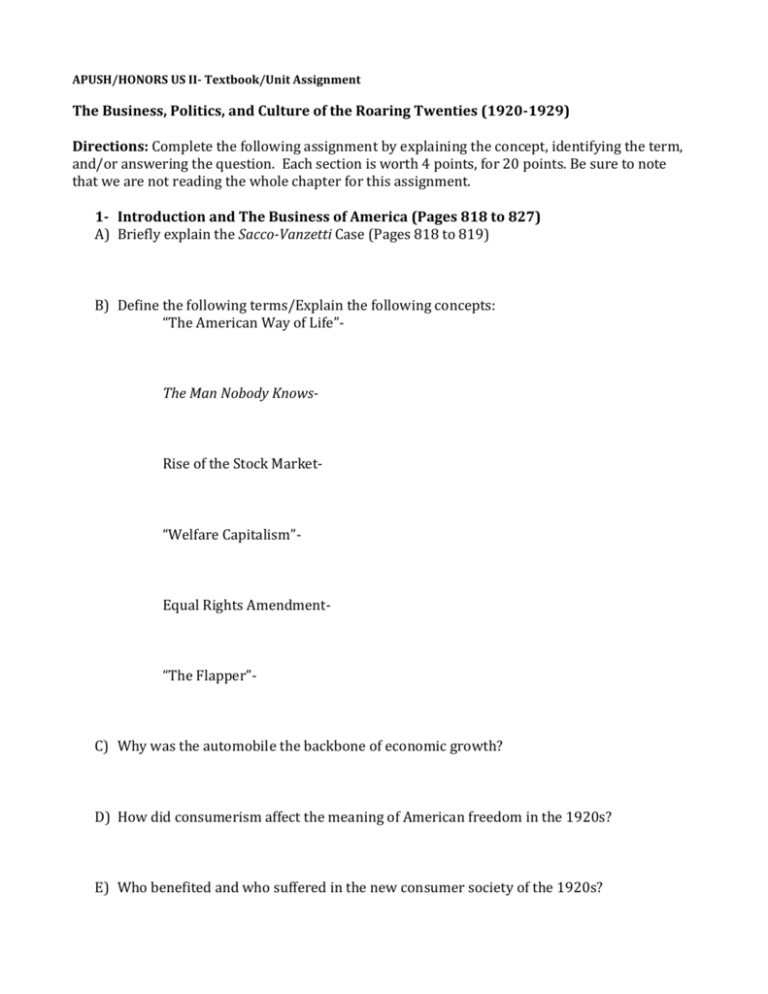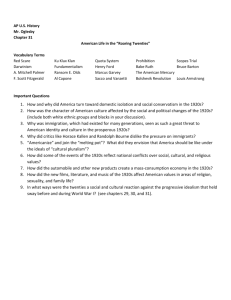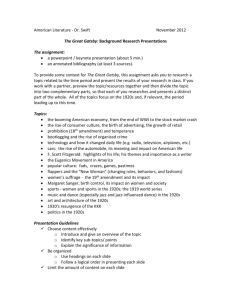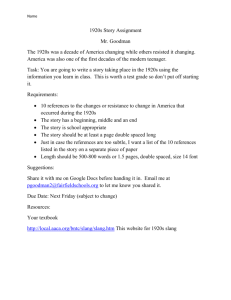APUSH/HONORS US II- Textbook/Unit Assignment The Business
advertisement

APUSH/HONORS US II- Textbook/Unit Assignment The Business, Politics, and Culture of the Roaring Twenties (1920-1929) Directions: Complete the following assignment by explaining the concept, identifying the term, and/or answering the question. Each section is worth 4 points, for 20 points. Be sure to note that we are not reading the whole chapter for this assignment. 1- Introduction and The Business of America (Pages 818 to 827) A) Briefly explain the Sacco-Vanzetti Case (Pages 818 to 819) B) Define the following terms/Explain the following concepts: “The American Way of Life”- The Man Nobody Knows- Rise of the Stock Market- “Welfare Capitalism”- Equal Rights Amendment- “The Flapper”- C) Why was the automobile the backbone of economic growth? D) How did consumerism affect the meaning of American freedom in the 1920s? E) Who benefited and who suffered in the new consumer society of the 1920s? F) How did business and government use the concept of personal liberty to attack the unions and the freedoms of American labor? G) How did the meanings of freedom change for American women in the 1920s? H) Why did Alice Paul see the ERA as a logical extension of the Nineteenth Amendment? 2- Business and Government (Pages 828 to 829; Pages 832 to 833) A) Define the following terms/Explain the following concepts: Teapot Dome ScandalMcNary-Haugen Farm Bill – B) How did observers explain the decrease in democracy and popular participation in the government during the decade? C) List three government policies that reflected the pro-business ethos of the 1920s. D) Who won and who lost in the election of 1924? E) Which country did American bankers loan large sums of money to? F) Explain the U.S. actions in Nicaragua. 3- The Birth of Civil Liberties (Pages 833 to 836) A) Define the following terms/Explain the following concepts: Hayes Code- American Civil Liberties Union- “Clear and Present Danger”- B) Explain how debates over free speech and the First Amendment redefined freedom by the end of the 1920s. C) List the two Supreme Court Justices began to speak up for freedom of speech. D) Identify who Anita Whitney was and the controversy surrounding her. E) Read page 831 dealing with the Meyer v. Nebraska case. What is the importance of this case towards civil liberties? F) Why did the protection of civil liberties gain importance in the 1920s? 4- The Culture Wars (Pages 836 to 847) A) Define the following terms/Explain the following concepts: Scopes Trial- “100 Percent Americanism”- “Illegal Alien”- The “New Negro”- B) Answer the two questions regarding Civil Activities with Dance Hall on page 837. C) Which groups and forces were the targets of fundamentalist opposition and why? D) How was the fundamentalist revolt a reaction to the modernization of American society in the 1920s? E) How did the actions of the Ku Klux Klan threaten American freedom in the 1920s? F) Explain the justifications for immigration restriction laws, as well as the reason for specific exemptions to these laws. G) Did U.S. society in the 1920s reflect the concept of cultural pluralism as explained by Horace Kallen? Why or why not? H) What were the major differences between fundamentalism and pluralism in the 1920s? I) Identify the two events that that made Harlem the “capital” of black America. J) In what ways did blacks express their freedom through the Harlem Renaissance?









